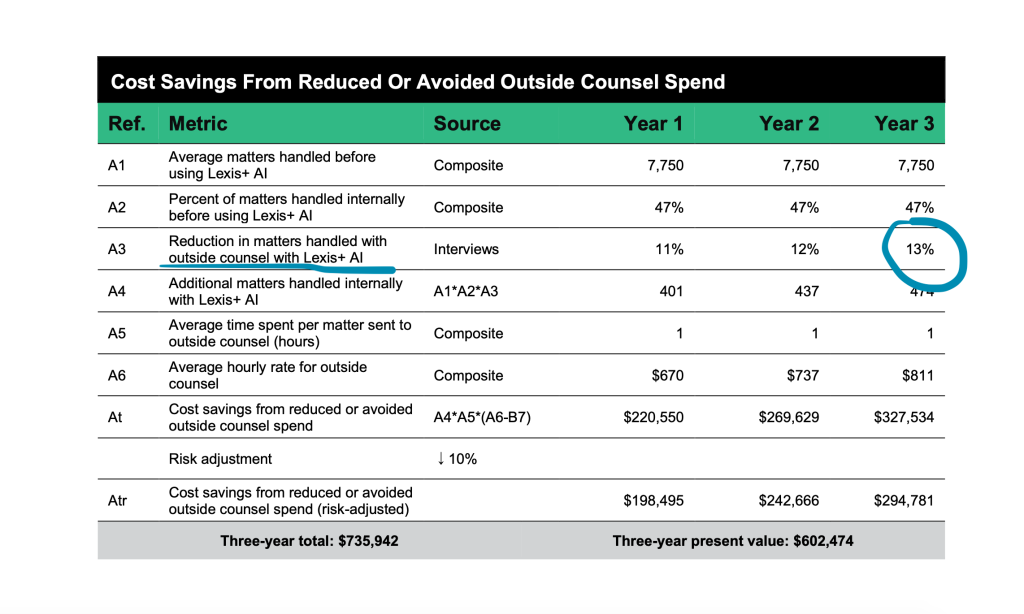
A new study by LexisNexis, conducted for them by Forrester, and using a model inhouse legal team of a hypothetical $10 billion company, found that if they were using AI tools at scale internally it could reduce work sent to law firms by 13%, based on the volume of matters handled.
Other key findings included:
‘A 25% reduction in annual time spent advising the business on legal inquiries’ (i.e. advising the business the inhouse team is within).
And, ‘Annual time savings of 50% for paralegals on administrative tasks’ (i.e. paralegals employed by the inhouse team).
To get to these results the consulting group Forrester interviewed four senior inhouse people ‘with experience using and deploying Lexis+ AI’ in their companies. They then combined the four companies into a ‘single composite organization based in North America with $10 billion in annual revenue and a corporate legal staff of 70 attorneys and 10 paralegals. Its legal budget is 0.33% of the organization’s annual revenue’. This scenario was then considered over three years, taking into account broad use of AI.
Now, although there is a clear effort to be empirical here, the dataset is very small – four companies – and the extrapolations on cost and time savings are from a composite entity over three years. So, let’s not get carried away here. It really is a model, not a set of facts.
That said, if all of the Fortune 500, for example, used AI tools across their inhouse teams at scale – and every day, not just occasionally – and actually were able to reduce the amount of work sent out to law firms by 13% in terms of the volume of matters, then that would total many $ millions in reductions of external legal spend across the US Big Law market.
For example, it’s estimated by The American Lawyer that the AmLaw 100’s collective revenue is $158 billion, so you can see the scale of impact here if 13% less work goes out in terms of the number of matters sent to law firms – albeit many of those matters may be for relatively small amounts, as that is the work that inhouse teams will be able to retain internally by using AI.
Of course, it has to be added again that this is not a scientific study, but even if we are very conservative here, we are looking at inhouse teams keeping back a noticeable amount of work in terms of Dollar value – based on this study’s findings.
And here is the key findings summary:
‘An up to 13% reduction in work handled with outside counsel. Time savings for attorneys and the paralegals who support them enable the composite organization to focus on more valuable work and, in turn, handle more work in- house. Work handled by outside counsel includes litigation case matters, transactions or deal work, and support on legal issues that may impact the business. The reduction in work handled by external law firms, particularly transactional matters and support on legal inquiries, increases the volume of matters the organization handles internally by 5% in the first year. Over three years and with a cumulative total of 1,312 additional matters handled internally, avoided outside counsel fees total more than $602,000 for the composite organization.
A 25% reduction in annual time spent advising the business on legal inquiries. Attorneys at the composite organization with access to Lexis+ AI expedite addressing legal inquiries by accelerating research, facilitating summaries, and drafting memos to communicate those findings to various stakeholders. The attorneys spend 20% of their time on legal questions and related tasks that are impacted by Lexis+ AI. Over three years and with a cumulative total of 56 attorneys using Lexis+ AI, the time savings on addressing legal inquiries are worth more than $574,000 to the composite organization.
Annual time savings of 50% for paralegals on administrative tasks. With Lexis+ AI, the composite organization’s paralegals reduce the time they spend summarizing and analyzing documents in preparation for legal work. For the impacted paralegals, 25% of their time is dedicated to case summarization and document analysis. Over three years and with a cumulative total of three paralegals using Lexis+ AI, the time savings are worth more than $53,000 to the composite organization.’
The study also found multiple unquantified, more human-scale benefits around quality of life and the ability to focus on more high value matters.

Overall, and as noted above, although this is a model – and models can be wrong – if this points at the way the future will unfold, then law firms have to work on the assumption total work per client may reduce, especially for those serving more of those ‘complex but routine’ needs.
For firms primarily handling only the most complex and high-risk matters they will likely not notice much change at all. But for those that prop up their incomes with more run of the mill legal needs that inhouse teams have previously sent out, then the study suggests things could get more competitive.
P.S. of course, new and unexpected legal demands may increase across the market that then increase again the level of work sent out to law firms. But, even so, legal AI tools may also then be adapted inhouse to handle those as well…Perhaps the balance of power is shifting….at least for this ‘routine but complex’ work?
—
Legal Innovators Conferences in New York and London – Both In November ’25
If you’d like to stay ahead of the legal AI curve….then come along to Legal Innovators New York, Nov 19 + 20, where the brightest minds will be sharing their insights on where we are now and where we are heading.

And also, Legal Innovators UK – Nov 4 + 5 + 6

Both events, as always, are organised by the awesome Cosmonauts team!
Please get in contact with them if you’d like to take part.
Discover more from Artificial Lawyer
Subscribe to get the latest posts sent to your email.

